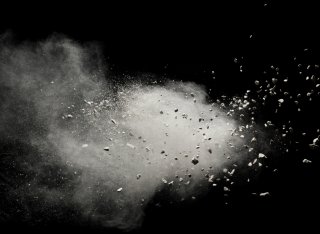
Dr Patrick Sears
Academic and research departments
School of Chemistry and Chemical Engineering, Faculty of Engineering and Physical Sciences.About
Biography
Dr Patrick Sears is a Senior Lecturer of Chemistry and Forensic analysis at the University of Surrey in the School of Chemistry and Chemical Engineering. His research expertise and background include developing analytical chemistry solutions for complex problems and understanding how analytical systems can be broken down to improve precision and accuracy. Dr Sears received his B.Sc. (1995) and M.Sc. (1996) from the University of Durham before completing a Ph.D. at the University of Hull completing research on the catalytic oxidation of isobutene by uranium oxide. After being awarded his PhD, Dr Sears worked in process safety analysis (at Rhodia CSD and Thermal Hazard Technology) and in reaction optimisation and flow chemistry (at Syrris) before joining the defence science and technology laboratory (Dstl) in 2008. At Dstl, Dr Sears was a team leader in the Forensic Explosives Laboratory and latterly a Principal Scientist in Explosives Detection where his main research interests were in the analysis of trace explosive contamination and residues.
Affiliations and memberships
ResearchResearch interests
Dr Patrick Sears's research interests include:
- Understanding production, transfer, spread and fate of trace contamination
(explosives, drugs, pharmaceuticals and within healthcare) - Establishing new analytical methods to determine the source, breakdown and fate of environmental pollutants and materials hazardous to health including Nitrosamines, PFAS and Pesticides
- Providing novel ionisation techniques for mass spectrometric analysis and identifying applications to create real-world impact
- Developing methods and systems for the direct analysis of materials on surfaces
- Understanding secondary ionisation processes
- Developing techniques for the forensic speciation of materials of interest
- Quantification of precision, accuracy and uncertainty of analytical systems of measurement
Research collaborations
Dr Sears has a wide range of industry collaborations ongoing including those with:
- Waters
- LGC
- AstraZeneca
- Dstl
- AWE
- Romil
- Restek
- SpectralWorks
- Shimadzu
Within the University of Surrey Dr Sears collaborates with:
- Dr Madeleine Bussemaker
- Dr Michael Short
- Dr Monica Felipe-Sotelo
- Professor Melanie Bailey
- Dr James Wright
- Dr Nat Bingham
Dr Sears is also currently working with academics at other universities including:
- Dr Liam Heaney - University of Loughborough
- Prof John Langley - University of Southampton
- Dr Steve Bleay and Hannah Smart - London Southbank University
- Dr David Megson - Manchester Metropolitan University
Research interests
Dr Patrick Sears's research interests include:
- Understanding production, transfer, spread and fate of trace contamination
(explosives, drugs, pharmaceuticals and within healthcare) - Establishing new analytical methods to determine the source, breakdown and fate of environmental pollutants and materials hazardous to health including Nitrosamines, PFAS and Pesticides
- Providing novel ionisation techniques for mass spectrometric analysis and identifying applications to create real-world impact
- Developing methods and systems for the direct analysis of materials on surfaces
- Understanding secondary ionisation processes
- Developing techniques for the forensic speciation of materials of interest
- Quantification of precision, accuracy and uncertainty of analytical systems of measurement
Research collaborations
Dr Sears has a wide range of industry collaborations ongoing including those with:
- Waters
- LGC
- AstraZeneca
- Dstl
- AWE
- Romil
- Restek
- SpectralWorks
- Shimadzu
Within the University of Surrey Dr Sears collaborates with:
- Dr Madeleine Bussemaker
- Dr Michael Short
- Dr Monica Felipe-Sotelo
- Professor Melanie Bailey
- Dr James Wright
- Dr Nat Bingham
Dr Sears is also currently working with academics at other universities including:
- Dr Liam Heaney - University of Loughborough
- Prof John Langley - University of Southampton
- Dr Steve Bleay and Hannah Smart - London Southbank University
- Dr David Megson - Manchester Metropolitan University
Teaching
Dr Sears is module leader and sole lecturer on the and the following courses:
Semester 1:
- CHE1039: Fundamentals of Forensic Science: From Crime Scene to Court
- SOC1042: Fundamentals of Forensic Science for Social Scientists
Semester 2:
- CHE2033: Forensic Chemistry
Dr Sears is the primary lecturer and module coordinator for the following courses:
Semester 1:
- CHE3055: Topics in Forensic Science
- CHEM034: Advanced Methods in Forensic Investigation
Dr Sears has chosen to use flipped learning to teach these modules, providing “bite sized” pre-recorded lecture content and using Surrey's virtual learning environment (SurreyLearn) to give students an immersive course using video and web content together with more traditional academic sources (academic literature and textbooks). This provides time and space within face-to-face sessions to unpack the key themes and to give formative assessment and feedback.
Sustainable development goals
My research interests are related to the following:





Publications
Short chain PFAS is known to be more challenging to destructively remove than its longer chain counterparts. Electrochemical oxidation at boron doped diamond (BDD) electrodes is one promising way forward. The majority of investigations are carried out using thin film, high grain density BDD electrodes (attached to the growth substrate) at low current densities of <50 mA cm–2. In this work, the impact of high current density on short chain (C4), perfluorobutanoic acid (PFBA), and perfluorobutanesulfonic acid (PFBS) removal rates and defluorination efficiency is investigated in a recirculating flow system. These studies are carried out using free-standing BDD electrodes, which are grown thick enough so that the BDD can be removed from the non-diamond growth substrate and thus contain a much lower grain density compared to thin-film BDD. The cell utilizes four BDD electrodes, where only the two outer electrodes are directly connected to a potential supply, the two inner electrodes are electrically unconnected, and driven in a bipolar arrangement. Solutions contain saturated potassium sulfate as the electrolyte. A current density of ≥390 mA cm–2 (after correcting for surface roughness) is employed for times up to 9 h. PFBS/PFBA concentrations in the range range ∼1–60 mg L–1 are investigated. Importantly when comparing rate constant data to literature for similar concentrations (after normalization of the rate constants to treatment volume/anode area), the values suggest removal rates approximately an order of magnitude higher than those at lower current density (in stirred solutions). Defluorination efficiency is also found to be higher with (close to) complete defluorination indicated at higher concentrations/longer times for short chain PFAS. Microscopy analysis of the free-standing electrodes after deployment for >90 h of advanced oxidation reveals no obvious signs of corrosion. This likely reflects both the reduced grain boundary density and lower sp2 carbon content in thick free-standing BDD. The data highlight the potential for this electrode material in long term electrochemical treatment of short chain PFAS solutions in recirculating flow systems.
The UK government has introduced legislation for a suite of drugs known to cause impairment to help combat driving under the influence of drugs (DUID). The current preliminary tests have limitations, which has pressed for an improvement of screening methods for on-site analysis. Ambient ionisation techniques and their coupling to low-cost miniaturised mass spectrometers have demonstrated promise for routine in-situ analyses. Associated advantages include minimum sample preparation, and rapid data acquisition in real-time. Preliminary experiments evaluated the use of atmospheric solids analysis probe (ASAP-) and thermal desorption (TD-) techniques in conjunction with a Waters QDa; which were assessed for their applicability to identify a small number of medicinal drugs in synthetic saliva and plasma, with the intention to support DUID incidents. Calibration standards were prepared in methanol, synthetic saliva and crashed plasma. Methanol and synthetic saliva were spiked directly with the drug, whilst crashed plasma was dried under nitrogen before being reconstituted with the corresponding concentration of drug in methanol. Samples were introduced into the ASAP- and TD-QDa by capillary tubes and PTFE-fibreglass coated swabs, respectively. Infinite dilutions were analysed in each matrix to estimate the limit of detection (LOD) for each drug. Variable cone voltages generated analyte-specific fragment ions and introduced a degree of specificity not normally associated with this type of mass spectrometer. High selectivity was observed also. Greater sensitivity was demonstrated by ASAP-QDa (LODs 1000 ng mL-1). An unmatched internal standard (IS) improved the linearity and standard error at each concentration of the calibration curve, as a matched IS shared fragment ions with two of the drugs present in the multi-analyte solution. Plasma analysed by ASAP-QDa yielded the greatest results at the tested concentration range. Overall, ASAP-QDa demonstrated greater promise for use as an in-situ screening method.
Plasma amino acid analysis plays a vital role in monitoring inherited metabolic diseases (IMDs), such as phenylketonuria (PKU), where dietary therapy is the cornerstone of management and patients are regularly monitored using blood or plasma phenylalanine throughout life. Recent findings from external quality assessment (EQA) schemes demonstrate large variability between results from different clinical laboratories. EQA schemes are hampered by factors including suboptimal sample type and frequency of distributions. Aiming to harmonise and standardise EQA schemes, this paper describes value assignment of an SI traceable matrix-matched amino acid material, and its use in an interlaboratory comparison (ERNDIM QAA-2106 study) that included 89 clinical laboratories from throughout Europe. The outcomes of the interlaboratory comparison are valuable in enabling clinical laboratories to refine their methodologies and, in a longer term, will lead to enhanced accuracy of results in clinical measurements and, ultimately, improved patient care in IMD management. A frozen, pooled human plasma sample was distributed to participating laboratories (n = 88). The sample was value assigned for phenylalanine by the National Measurement Laboratory (NML) traceable to the international system of units (SI), at approximately the target value for dietary monitoring of phenylketonuria (360 µmol/L). Participants used their routine method of analysis to measure 24 amino acids in triplicate and results were compared against desirable analytical performance. Mean intra-and inter-laboratory variability were acceptable for 20/20 and 19/20 amino acids respectively. Mean bias relative to the consensus values was acceptable for 17/20 amino acids. Overall performance of phenylalanine was acceptable; however, 15/87 laboratories failed to meet acceptable imprecision and 8/87 had unacceptable bias; additionally, an overall negative bias for phenylalanine measurement was identified. This study demonstrates the importance of ensuring a matrix material with an assigned value of the analyte(s) of interest (traceable to the SI) is available for regular EQA. The significant bias in the routine measurement of phenylalanine identified has the potential to impact disease management, which aims to control blood phenylalanine concentrations for preventing adverse neurological outcomes.
The utilization of ambient ionization (AI) techniques for mass spectrometry (MS) has significantly grown due to their ability to facilitate rapid and direct sample analysis with minimal sample preparation. This study investigates the performance of various AI techniques, including atmospheric solids analysis probe (ASAP), thermal desorption corona discharge (TDCD), direct analysis in real time (DART), and paper spray coupled to a Waters QDa mass spectrometer. The focus is on evaluating the linearity, repeatability, and limit of detection (LOD) of these techniques across a range of analytes, including amino acids, drugs, and explosives. The results show that each AI technique exhibits distinct advantages and limitations. ASAP and DART cover high concentration ranges, which may make them suitable for semiquantitative analysis. TDCD demonstrates exceptional linearity and repeatability for most analytes, while paper spray offers surprising LODs despite its complex setup (between 80 and 400 pg for most analytes). The comparison with electrospray ionization (ESI) as a standard method shows that ambient ionization techniques can achieve competitive LODs for various compounds such as PETN (80 pg ESI vs 100 pg ASAP), TNT (9 pg ESI vs 4 pg ASAP), and RDX (4 pg ESI vs 10 pg ASAP). This study underscores the importance of selecting the appropriate ambient ionization technique based on the specific analytical requirements. This comprehensive evaluation contributes valuable insights into the selection and optimization of AI techniques for diverse analytical applications.
RATIONALE: Paper spray offers a rapid screening test without the need for sample preparation. The incomplete extraction of paper spray allows for further testing using more robust, selective and sensitive techniques such as liquid chromatography mass spectrometry (LC-MS). Here we develop a two-step process of paper spray followed by LC-MS to (1) rapidly screen a large number of samples and (2) confirm any disputed results. This demonstrates the applicability for testing medication adherence from a fingerprint. METHODS: Following paper spray analysis, drugs of abuse samples were analysed using LC-MS. All analyses were completed using a Q Exactive™ Plus Orbitrap™ mass spectrometer. This two-step procedure was applied to fingerprints collected from patients on a maintained dose of the antipsychotic drug quetiapine. RESULTS: The extraction efficiency of paper spray for two drugs of abuse and metabolites was found to be between 15-35% (analyte dependent). For short acquisition times, the extraction efficiency was found to vary between replicates by less than 30%, enabling subsequent analysis by LC-MS. This two-step process was then applied to fingerprints collected from two patients taking the antipsychotic drug quetiapine, which demonstrates how a negative screening result from paper spray can be resolved using LC-MS. CONCLUSIONS: We have shown for the first time the sequential analysis of the same sample using paper spray and LC-MS, as well as the detection of an antipsychotic drug from a fingerprint. We propose that this workflow may also be applied to any type of sample compatible with paper spray, and will be especially convenient where only one sample is available for analysis.
Direct analyte probed nanoextraction (DAPNe) is a technique that allows extraction of drug and endogenous compounds from a discrete location on a tissue sample using a nano capillary filled with solvent. Samples can be extracted from a spot diameters as low as 6 µm. Studies previously undertaken by our group have shown that the technique can provide good precision (5%) for analysing drug molecules in 150 µm diameter areas of homogenised tissue, provided an internal standard is sprayed on to the tissue prior to analysis. However, without an isotopically labelled standard, the repeatability is poor, even after normalisation to and the spot area or matrix compounds. By application to tissue homogenates spiked with drug compounds, we can demonstrate that it is possible to significantly improve the repeatability of the technique by incorporating a liquid chromatography separation step. Liquid chromatography is a technique for separating compounds prior to mass spectrometry (LC-MS) which enables separation of isomeric compounds that cannot be discriminated using mass spectrometry alone, as well as reducing matrix interferences. Conventionally, LC-MS is carried out on bulk or homogenised samples, which means analysis is essentially an average of the sample and does not take into account discrete areas. This work opens a new opportunity for spatially resolved liquid chromatography mass spectrometry with precision better than 20%.
The development of ambient ionization mass spectrometry (AIMS) has transformed analytical science, providing the means of performing rapid analysis of samples in their native state, both in and out of the laboratory. The capacity to eliminate sample preparation and pre-MS separation techniques, leading to true real-time analysis, has led to AIMS naturally gaining a broad interest across the scientific community. Since the introduction of the first AIMS techniques in the mid-2000s, the field has exploded with dozens of novel ion sources, an array of intriguing applications, and an evident growing interest across diverse areas of study. As the field continues to surge forward each year, ambient ionization techniques are increasingly becoming commonplace in laboratories around the world. This annual review provides an overview of AIMS techniques and applications throughout 2022, with a specific focus on some of the major fields of research, including forensic science, disease diagnostics, pharmaceuticals and food sciences. New techniques and methods are introduced, demonstrating the unwavering drive of the analytical community to further advance this exciting field and push the boundaries of what analytical chemistry can achieve.
The degradation of paracetamol, a widely found emerging pharmaceutical contaminant, was investigated under a wide range of single-frequency and dual-frequency ultrasonic irradiations. For single-frequency ultrasonic irradiation, plate transducers of 22, 98, 200, 300, 400, 500, 760, 850, 1000, and 2000 kHz were employed and for dual-frequency ultrasonic irradiation, the plate transducers were coupled with a 20 kHz ultrasonic horn in opposing configuration. The sonochemical activity was quantified using two dosimetry methods to measure the yield of HO• and H2O2 separately, as well as sonochemiluminescence measurement. Moreover, the severity of the bubble collapses as well as the spatial and size distribution of the cavitation bubbles were evaluated via sonoluminescence measurement. The paracetamol degradation rate was maximised at 850 kHz, in both single and dual frequency ultrasonic irradiation. A synergistic index higher than 1 was observed for all degrading frequencies (200–1000 kHz) under dual frequency ultrasound irradiation, showing the capability of dual frequency system for enhancing pollutant degradation. A comparison of the results of degradation, dosimetry, and sonoluminescence intensity measurement revealed the stronger dependency of the degradation on the yield of HO• for both single and dual frequency systems, which confirms degradation by HO• as the main removal mechanism. However, an enhanced degradation for frequencies higher than 500 kHz was observed despite a lower HO• yield, which could be attributed to the improved mass transfer of hydrophilic compounds at higher frequencies. The sonoluminescence intensity measurements showed that applying dual frequency ultrasonic irradiation for 200 and 400 kHz made the bubbles larger and less uniform in size, with a portion of which not contributing to the yield of reactive oxidant species, whereas for the rest of the frequencies, dual frequency ultrasound irradiation made the cavitation bubbles smaller and more uniform, resulting in a linear correlation between the overall SL intensity and the yield of ROS.
Fingermark recovery plays a crucial role in investigating corrosive substance attacks, which are becoming increasingly common. Building upon previous research, this study aimed to identify effective visualization processes for recovering fingermarks from diverse substrates exposed to wide range of commercially available corrosive materials. The study investigated glass, PVC and HDPE substrates with fingermarks deposited 1 day and 2 weeks before exposure to the corrosive substance, and used commercially available substances at concentrations higher than any previous study. It was found that fingermarks could still be recovered from all substrates studied after exposure to most of the corrosive substances, although in general exposure to corrosive substances was detrimental to the quality of marks recovered. The most detrimental corrosive substances were found to be those based on concentrated sulfuric acid. Black and white powder suspensions were the most effective of all processes used in this study, with the highest recovery rates observed from the glass substrate. Age of mark was not found to have a significant effect on recovery rates. Overall the results show that fingermarks may survive exposure to even the most concentrated acids used in this study and provide the initial basis for guidance on processes that could be used on materials used in corrosive substance attacks.•Effect of high concentration commercial corrosive substances on fingermark recovery studied.•Range of substrates, corrosive substances and age of marks extended beyond previous research.•Fingermarks still developed after exposure to concentrated (18 M) sulfuric acid.•Alkali solutions more detrimental to fingermarks than acids of equivalent concentration.•Powder suspensions found to be the most effective processes for fingermark recovery.
The ability to determine the purity (% controlled compound) of drug‐of‐abuse samples is necessary for public health and law enforcement. Here, we describe the assessment of atmospheric solids analysis probe (ASAP) for the rapid determination of drug purity for a set of formulated pharmaceuticals, chosen due to their availability, uncontrolled status and consistency. Paracetamol and loratadine were used as models of high and low purity compounds being ~90% and ~10% active ingredient, respectively. Individual tablets were ground up and diluted in an internal standard solution. The resulting samples were analysed by ASAP coupled to a Waters QDa mass spectrometer followed by confirmatory testing by liquid chromatography–tandem mass spectrometry (LC–MS/MS). The inclusion of a non‐matched internal standard (quinine) improved linearity and repeatability of drug analysis by ASAP‐MS. Levels of drug purity using formulated pharmaceutical tablets were found to be highly comparable with results produced by the ‘gold standard’ LC–MS/MS technique. Rapid determination of drug purity is therefore possible with ASAP‐MS for highly concentrated samples with minimal sample preparation. It may be possible to use this deployable system to determine drug purity outside of a laboratory setting.
Five different classes of explosives were analysed by ambient ionisation mass spectrometry testing selectivity, sensitivity, and repeatability. We compare the effectiveness of two techniques (ASAP and SESI) for the trace detection of five explosives representative of the most common classes of high explosive: HMTD, RDX, PETN, Tetryl and TNT. Experiments also compared the effectiveness of sample loading via a glass fibre swab or glass rod. All analyses were carried out with a Waters Acquity QDa mass spectrometer, a small format mass spectrometer which can be operated in a transportable mode (using ambient air and a small diaphragm pump). Both ambient ionisation techniques, ASAP and SESI, successfully detected the five different explosives which could make them suitable for a screening method. By directly comparing a calibration range of 0.8–10 ng on both swabs and rods for each explosive, it appears that SESI produces less variability per repeat, particularly at the higher end of the range when compared to ASAP which typically has a lower limit of detection and better linearity.
Ambient ionization (AI) is a rapidly growing field in mass spectrometry (MS). It allows for the direct analysis of samples without any sample preparation, making it a promising technique for the detection of explosives. Previous studies have shown that AI can be used to detect a variety of explosives, but the exact gas-phase reactions that occur during ionization are not fully understood. This is further complicated by differences in mass spectrometers and individual experimental set ups between researchers. This study investigated the gas-phase ion reactions of five different explosives using a variety of AI techniques coupled to a Waters QDa mass spectrometer to identify selective ions for explosive detection and identification based on the applied ambient ionization technique. The results showed that the choice of the ion source can have a significant impact on the number of ions observed. This can affect the sensitivity and selectivity of the data produced. The findings of this study provide new insights into the gas-phase ion reactions of explosives and could lead to the development of more sensitive and selective AI-based methods for their detection.
Direct analysis in real time is typically performed using helium as the ionisation gas for the detection of analytes by mass spectrometry (MS). Nitrogen and argon are found with abundance in the air and provide a cheaper and greener alternative to the use of helium as ionisation gas. This study explores the use of helium, nitrogen and argon as ionisation gas for detection of organic compounds. Four illicit drugs, 2 amino acids and 5 explosives were chosen as target analytes to understand selectivity, sensitivity and linearity when helium, nitrogen or argon was used as the ionisation gas with the direct analysis in real time (DART) source. Analysis was carried out on a Waters Acquity QDa single quadrupole mass spectrometer. Calibration curves over the range of 5 - 100 ng were produced for each analyte using the different ionisation gases to assess the instrument response. Nitrogen gave a higher response to concentration than helium or argon, however the lowest limits of detection were observed when helium was used. All the target analytes were detected using DART-MS with helium, nitrogen or argon as the ionisation gas. Whilst helium provides the highest sensitivity, nitrogen produced reasonable limits of detection and had good linearity across the concentration range explored, suggesting it provides a greener and cheaper alternative to helium.
Paper spray mass spectrometry is a rapid and sensitive tool for explosives detection but has so far only been demonstrated using high resolution mass spectrometry, which bears too high a cost for many practical applications. Here we explore the potential for paper spray to be implemented in field applications with portable mass spectrometry. This involved (a) replacing the paper substrate with a swabbing material (which we call “swab spray”) for compatibility with standard collection materials; (b) collection of explosives from surfaces; (c) an exploration of interferences within a ± 0.5 m/z window; and (d) demonstration of the use of high-field assisted waveform ion mobility spectrometer (FAIMS) for enhanced selectivity. We show that paper and Nomex® are viable collection materials, with Nomex providing cleaner spectra and therefore greater potential for integration with portable mass spectrometers. We show that sensitive detection using swab spray will require a mass spectrometer with a mass resolving power of 4000 or more. We show that by coupling the swab spray ionisation source with FAIMS, it is possible to reduce background interferences, thereby facilitating the use of a low resolving power (e.g. quadrupole) mass spectrometer.
Rationale High costs and student numbers can often hinder implementation of mass spectrometry (MS) in the undergraduate teaching laboratory, often with technicians running samples on students' behalf, and the implementation of MS only in discrete or isolated experiments. This study explores the use of atmospheric solids analysis probe MS (ASAP‐MS) as a relatively low‐cost, benchtop instrument, and its potential for application as a ‘bolt‐on’ to existing undergraduate organic chemistry experiments. Methods Thirteen products synthesised in undergraduate laboratory experiments were analysed by ASAP‐MS, along with their starting materials. Analysis was carried out with a Waters RADIAN ASAP mass spectrometer, at four different cone voltages simultaneously to provide fragmentation information. Results Out of the 13 undergraduate experiments, ASAP‐MS was shown to be complementary in 11 of these, either through simple analysis of the precursor ion or by a more complex analysis of the fragments. Conclusions ASAP‐MS provided spectra that both complement and enhance intended learning outcomes in existing organic chemistry experiments, showing its versatility as a bolt‐on technique. Moving forward, ASAP‐MS will be integrated into the University of Surrey's undergraduate teaching laboratory.
Additional publications
Publications from earlier in Dr Sears's career:
Performance validation of step-isothermal calorimeters: Application of a test and reference reaction. (2006) B.A. Finnin, M.A.A. O’Neill, S. Gaisford, A.E. Beezer, J. Hadgraft and P. Sears. J. Therm. Anal. Cal.83:331-334. https://doi.org/10.1007/s10973-005-7223-5
A Comparison of the performance of calorimeters: Application of a test and reference reaction. (2006) M.A.A. O’Neill, S. Gaisford, A.E. Beezer, C.V. Skaria, P. Sears. J. Therm. Anal. Cal. 84:301-306. https://doi.org/10.1007/s10973-005-7488-8
Kinetic Investigations of Product Inhibition in the Amino Alcohol-Catalyzed Asymmetric Alkylation of Benzaldehyde with Diethylzinc (2000) T. Rosner, P.J. Sears, W.A. Nugent, D.G. Blackmond. Organic Lett. 2:2551-2513. https://doi.org/10.1021/ol006181r
Synergic interactions in a urania–titania catalyst for isobutene partial oxidation. (2000) A.F.Lee, P.J. Sears, S.D. Pollington, T.L. Overton, P.B. Wells, D.F. Lee. Catal. Lett. 70:183-186. https://doi.org/10.1023/A:1018801804706
Novel supported uranium oxide catalysts for NOx abatement. (1999) S.D. Pollington, A.F. Lee, T.L. Overton, P.J. Sears, P.B. Wells, S.E. Hawley, I.D. Hudson, D.F. Lee, V.Ruddock. Chem. Commun., 1999, 725-726. https://doi.org/10.1039/A900802K

